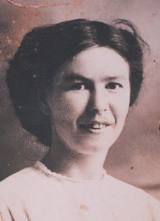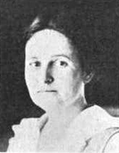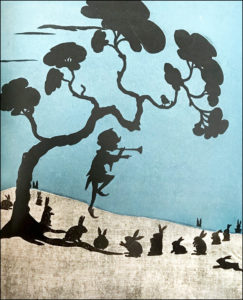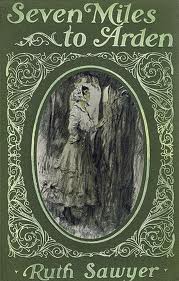Ruth Sawyer facts for kids
Quick facts for kids
Ruth Sawyer
|
|
|---|---|

Sawyer
|
|
| Born | August 5, 1880 Boston, Massachusetts, USA |
| Died | June 3, 1970 Lexington, Massachusetts, USA |
| Occupation | Storyteller, teacher, writer |
| Nationality | American |
| Education | B.S., Columbia University |
| Genre | Children's literature |
| Notable works |
|
| Notable awards | Newbery Medal 1937 Laura Ingalls Wilder Award 1965 |
| Spouse | Albert C. Durand (m. 1911) |
Ruth Sawyer (born August 5, 1880 – died June 3, 1970) was an American storyteller and a writer. She wrote many books for children and adults. She is best known for her book Roller Skates, which won the important Newbery Medal in 1937. In 1965, she also received the Laura Ingalls Wilder Award for her amazing work in children's literature throughout her life.
Contents
Ruth Sawyer's Early Life
Ruth Sawyer was born in Boston, Massachusetts, on August 5, 1880. She was the youngest of five children and the only girl. When she was a baby, her family moved to New York City. Ruth came from a wealthy family. She had an Irish nanny named Joanna, who taught her to love and appreciate storytelling.
After her father passed away, her family moved to their summer home in Maine. They lived simply, using what the land provided. Ruth later wrote about this experience in her novel, The Year of Jubilo. Eventually, the family returned to New York. Ruth then studied at the Garland Kindergarten Training School for two years.
Becoming a Storyteller
In 1900, Ruth Sawyer traveled to Cuba. There, she taught storytelling to teachers. These teachers were opening kindergartens for children who had lost their parents during the Spanish–American War. When she returned to the United States, her work in Cuba helped her get a scholarship to Columbia University. At Columbia, she studied storytelling and folk lore. She earned her degree in education in 1904.
After college, she worked for the New York school system. She told stories to people who had recently moved to the country. In 1910, she started the very first storytelling program for children at the New York Public Library.
Ruth also wrote articles for The New York Sun newspaper. They sent her to Ireland twice to study. During these trips and others overseas, she collected many folk tales. She became very good at storytelling. Her life experiences often gave her ideas for her books. She spent her life collecting and sharing folk tales. Some people even compared her to the famous Brothers Grimm who collected fairy tales.
Family Life
In 1911, Ruth Sawyer married Albert C. Durand, an eye doctor. They lived in Ithaca, New York. They had two children, Margaret (Peggy) and David. Peggy later became a children's librarian. She married Robert McCloskey, who became a famous children's author and illustrator. He is well known for writing books like Make Way for Ducklings.
From 1923 to 1933, Ruth worked for Cornell University Extension Services. She traveled through rural New York, telling stories and talking about books. In 1931, when she was 51, she traveled around Spain. Even though Spain was facing a Civil War, she collected folk tales there. During this trip, she met a young boy who inspired her book Tono Antonio.
From 1935 to 1945, Ruth visited the West Virginia Federal Reformatory for Women every month. She told stories to the women there. She met a Hungarian woman who shared stories about Christmas in her country. This inspired Ruth's book, The Christmas Anna Angel.
After her husband retired in 1946, they moved to Maine. They lived there until 1956, when they moved back to Boston. In 1965, she received the Regina Medal for her "continued, distinguished contribution to children's literature." That same year, she also received the Laura Ingalls Wilder Award. This award honors authors or illustrators whose books have made a "substantial and lasting contribution to literature for children."
Ruth Sawyer never stopped writing, traveling, or telling stories. When she was 81, she went to Austria. She researched the legend of the Dwarf King named Laurin.
Ruth Sawyer, often called "the great lady of American storytelling," passed away on June 3, 1970, in Lexington, Massachusetts.
Ruth Sawyer's Writing Career
Ruth Sawyer's first book for adults was a novel called The Primrose Ring in 1915. It was even made into a silent film in 1917.
The next year, she published her first book for children, This Way to Christmas. The story is about a young boy named David, based on her own son. His parents go on a trip and leave him with an Irish couple, Joanna and Barney. In each chapter, David hears a new Christmas story or folk tale.
Ruth published a new book almost every year for the next twenty years.
Famous Books for Children
Her most famous book, Roller Skates, came out in 1936. This book is like a fictional autobiography. It tells the story of ten-year-old Lucinda Wyman for one year. Lucinda's parents travel to Europe and leave her with two women in New York City. Lucinda has a lot of freedom. She roller skates all over the city, meeting people from different backgrounds. Roller Skates was considered very modern for its time. It showed Lucinda's freedom and how she dealt with difficult things, like the death of two friends. This book won the 1937 Newbery Medal.
The Year of Jubilo is a follow-up to Roller Skates. Published in 1940, it takes Lucinda and her family to Maine after her father dies. Again, Ruth used parts of her own life in the story.
In 1941, two more of Ruth's books were published:
- The Least One, a children's story illustrated by Leo Politi.
- The Long Christmas, a collection of thirteen Christmas legends, rhymes, and carols from around the world.
Ruth's next books appeared in 1944. The Way of the Storyteller is a guide for people who want to learn how to tell stories. It gives tips for performing, remembering stories, and getting better at storytelling. The second part has eleven stories that are great for telling aloud. This book was used as a textbook for teachers, librarians, and storytellers for many years.
The second book Ruth published in 1944 was The Christmas Anna Angel. This story was based on what she heard from a woman at the West Virginia Federal Reformatory. It's about a young girl growing up in Hungary during World War II. The war made it hard for families to celebrate. But the girl in the story believes an angel will bring a miracle for Christmas. The book was illustrated by Hungarian-born Kate Seredy and was a runner-up for the Caldecott Medal.
By this time, Ruth Sawyer was writing mostly for children. She published several more children's books in the late 1940s and 1950s. One was Maggie Rose, Her Birthday Christmas. This story is set in Maine. It's about a young girl's dream for a real Christmas birthday party. It was illustrated by Maurice Sendak.
For Journey Cake, Ho!, Ruth worked with her son-in-law, Robert McCloskey. Ruth wrote the story, which was a new version of the "run-away food" theme, like The Gingerbread Man. Robert McCloskey drew the pictures and was a runner-up for the 1954 Caldecott Medal.
Ruth Sawyer's last children's novel was Daddles, The Story of a Plain Hound-Dog. In this book, the narrator remembers three summers she and her brother spent at their cottage in Maine. They shared their adventures with a hunting dog named Daddles. The third summer, they returned to find their friend had passed away.
The Art of Storytelling
Ruth Sawyer was known as a "storyteller with amazing gifts." Her stories, both spoken and written, were like "living folk-art." Children's literature expert May Hill Arbuthnot said she was "a fine storyteller with a perfect sense of words, mood, and the music of narration." She added, "There is no one else who can relate Irish stories as she does." Librarians Brandi Florence and Erica Jarvis wrote that Ruth "had an ability to take old narratives and give them new life." This made them easy for new generations to enjoy.
Ruth Sawyer's Books
Children's Fiction
- The Tale of the Enchanted Bunnies (1923)
- Tono Antonio (1934)
- Roller Skates, illustrated by Valenti Angelo (1936) ^
- The Year of Jubilo (1940)
- The Least One (1941)
- The Christmas Anna Angel (1944) #
- Maggie Rose, Her Birthday Christmas (1952)
- The Enchanted Schoolhouse, illustrated by Hugh Troy (1956)
- The Year of the Christmas Dragon, illustrated by Troy (1960)
- Dietrich of Berne and the dwarf king Laurin, with Emmy Molles, illustrated by Frederick Chapman (1963)
- Daddles, The Story of a Plain Hound-Dog (1964)
Other Children's Books
- This Way to Christmas (1915), revised 1967
- The Long Christmas (1941)
- Journey Cake, Ho! (1953) #
- My Spain: A Storyteller's Year of Collecting (1967)
- ^ Newbery Medal winner
- # Caldecott Honor books—runners-up for the picture book illustration award
Adult Fiction
- The Primrose Ring (1915)
- Seven Miles to Arden (1916)
- Herself, Himself, and Myself: A Romance (1916)
- Leerie (1920)
- Folkhouse: The Autobiography of a Home (1934)
- Gallant: The Story of Storm Veblun (1936)
Non-Fiction and Recordings
- The Way of the Storyteller (1942), revised 1962
- How to Tell a Story (1962)
- Ruth Sawyer, Storyteller (1965) (Audio Recording)




